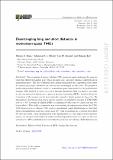| dc.contributor.author | Ebert, Markus A. | |
| dc.contributor.author | Michel, Johannes K. L. | |
| dc.contributor.author | Stewart, Iain W. | |
| dc.contributor.author | Sun, Zhiquan | |
| dc.date.accessioned | 2022-07-25T12:34:07Z | |
| dc.date.available | 2022-07-25T12:34:07Z | |
| dc.date.issued | 2022-07-20 | |
| dc.identifier.uri | https://hdl.handle.net/1721.1/144003 | |
| dc.description.abstract | Abstract
The extraction of nonperturbative TMD physics is made challenging by prescriptions that shield the Landau pole, which entangle long- and short-distance contributions in momentum space. The use of different prescriptions then makes the comparison of fit results for underlying nonperturbative contributions not meaningful on their own. We propose a model-independent method to restrict momentum-space observables to the perturbative domain. This method is based on a set of integral functionals that act linearly on terms in the conventional position-space operator product expansion (OPE). Artifacts from the truncation of the integral can be systematically pushed to higher powers in ΛQCD/kT. We demonstrate that this method can be used to compute the cumulative integral of TMD PDFs over
k
T
≤
k
T
cut
$$ {k}_T\le {k}_T^{\mathrm{cut}} $$
in terms of collinear PDFs, accounting for both radiative corrections and evolution effects. This yields a systematic way of correcting the naive picture where the TMD PDF integrates to a collinear PDF, and for unpolarized quark distributions we find that when renormalization scales are chosen near
k
T
cut
$$ {k}_T^{\mathrm{cut}} $$
, such corrections are a percent-level effect. We also show that, when supplemented with experimental data and improved perturbative inputs, our integral functionals will enable model-independent limits to be put on the non-perturbative OPE contributions to the Collins-Soper kernel and intrinsic TMD distributions. | en_US |
| dc.publisher | Springer Berlin Heidelberg | en_US |
| dc.relation.isversionof | https://doi.org/10.1007/JHEP07(2022)129 | en_US |
| dc.rights | Creative Commons Attribution | en_US |
| dc.rights.uri | https://creativecommons.org/licenses/by/4.0/ | en_US |
| dc.source | Springer Berlin Heidelberg | en_US |
| dc.title | Disentangling long and short distances in momentum-space TMDs | en_US |
| dc.type | Article | en_US |
| dc.identifier.citation | Journal of High Energy Physics. 2022 Jul 20;2022(7):129 | en_US |
| dc.contributor.department | Massachusetts Institute of Technology. Center for Theoretical Physics | |
| dc.identifier.mitlicense | PUBLISHER_CC | |
| dc.eprint.version | Final published version | en_US |
| dc.type.uri | http://purl.org/eprint/type/JournalArticle | en_US |
| eprint.status | http://purl.org/eprint/status/PeerReviewed | en_US |
| dc.date.updated | 2022-07-24T03:11:55Z | |
| dc.language.rfc3066 | en | |
| dc.rights.holder | The Author(s) | |
| dspace.embargo.terms | N | |
| dspace.date.submission | 2022-07-24T03:11:55Z | |
| mit.license | PUBLISHER_CC | |
| mit.metadata.status | Authority Work and Publication Information Needed | en_US |
